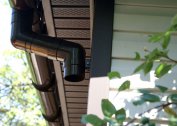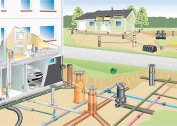To equip the sewage system in the house, in particular for risers, sewer pipes and drains to the treatment plant, sleeves with a diameter of 100 mm from various materials are used. The correct choice of sections of the main is important for the correct functioning of the entire sewer system.
Scope and design indicators
A pipe with a cross section of 100 mm is universal. It is used to equip both internal and external sewers. In the first case, it is used for risers and connecting toilets.
An external sewage line is a system of pipes, fittings, and other elements located outside the building and necessary to connect the pipeline to a sewage collection tank. The use of pipe sections with a cross section of 100 mm is possible if the treatment plant does not differ in gigantic dimensions and performance, and no more than three permanent residents live in the house. Otherwise, an external trunk of a larger cross section will be required.
Designs for internal systems are painted in gray or white. They have smooth walls and lower strength than their external counterparts. The latter most often have a red tint, they are corrugated when made from polymers.
Pipes for sewage are delivered in lengths from half a meter to 12 m. Data on the section and wall thickness are indicated by the manufacturers on the outside of the products. The greater the length and thickness, the greater the weight of the product.
Materials of manufacture
Often used for the production of pipes are various polymers: polyvinyl chloride, polypropylene, polyethylene. However, pipelines of this section are also created from other materials.
Advantages and disadvantages of polymer highways
Pipe sections from polyvinyl chloride most popular. PVC products are used to install new pipelines and repair existing ones. They are distinguished by such quality indicators:
- resistance to mineral oils, acids and alkalis;
- density from 1.35 to 1.43 g / cm3;
- dielectric qualities;
- budget cost.
A PVC sewer pipe with a diameter of 100 mm costs from 88 rubles per linear meter.
Of the minuses, low resistance to physical loads, as well as deformation of the structure at a temperature of 65 degrees, are noted. This creates certain restrictions for the movement of wastewater with a high temperature. Such products are not used for the external sewer line, since no strong physical loads should affect the pipeline. To rotate the pipe, fittings must be used. If you try to independently bend the pipe segment without the use of special parts, this can cause damage to it.
Polypropylene Considered a universal polymer, it has the following advantages:
- resistance to the action of abrasive particles;
- resistance to temperatures up to 140 degrees of heat;
- immunity to the effects of concentrated acidic media.
The density of the material is 0.91 g / cm3, so polypropylene pipes are the lightest among all analogues from the polymer. Corrugated pipes for an external line are usually made of this material.
The price of such highways is higher than polyvinyl chloride - from 125 rubles.
Another option for plastic pipes is polyethylene. They are used for installation of both external and internal house pipelines.The price per meter of plastic pipe for sewage based on polyethylene with a diameter of 100 mm - from 320 rubles. The advantages of pipelines are resistance to clogging due to slippery internal surface, resistance to temperatures below zero and aggressive environments. However, they cannot stand hot liquids warmer than 80 degrees.
It is possible to level the disadvantage using pipes made of cross-linked polyethylene. They are characterized by increased resistance to high temperatures, which allows them to be used for transporting hot effluents.
Features of pipelines made of other materials
Sewer highways carry cast iron and steel (galvanized or stainless).
The main advantages of steel structures:
- high strength;
- resistance to temperature differences;
- resistance to any aggressive reagents.
Of the disadvantages, severity and susceptibility to corrosion are noted. Stainless steel is an expensive material (from 350 rubles per kg), so the use of pipes in country houses and apartments is not advisable. Usually they are used in food, perfumery industries, or, for example, in the oil industry.
Cast iron pipes are even heavier in weight than steel, but they have enhanced anti-corrosion properties. Most often used in the installation of risers in high-rise buildings, as well as for the disposal of wastewater in the citywide system. They are extremely durable and able to last a century, inexpensive (from 15 rubles per kg), but the roughness of the inner part of the pipe sections makes it difficult to drain. For tight connection of pipes it is necessary to use additional materials.
Ceramic, concrete and asbestos-cement pipes are less commonly used. They are carried out only outside the building. Highways made of ceramics are used for transportation of domestic, industrial and rain drains. They are resistant to chemicals and corrosion, fireproof, strong and durable. The cost of such products starts from 790 rubles per linear meter.
Installation difficulties, fragility, high price and a number of other shortcomings became the reason that ceramics were replaced by other materials, more modern and practical.
Reinforced concrete pipes are used in hydraulic engineering, civil and industrial construction to move non-aggressive sewage by gravity. For their manufacture, heavy concrete solutions of the following grades are used: W6, F200, B25, M350.
The main advantages of reinforced concrete products:
- compressive and tensile strength;
- water tightness;
- resistance to low temperatures;
- chemical resistance;
- immunity to rot and rust.
They are also extremely heavy and require the use of special equipment. Reinforced concrete pipes are installed at a depth of 2 to 6 meters. The price starts from 3500 rubles for a product of 2.5 m.
Sewer pipelines made of asbestos cement are produced only at domestic plants. They are considered the cheapest among all types (from 300 rubles for a product 3.95 m long). The material is tensile, for this reason it can be used to create systems under pressure. It is immune to rust, and under the influence of water it compacts and gains strength. In most western countries, asbestos cement is prohibited, it is believed that it is capable of releasing toxic substances.
Each product has its own period of operation. For example, plastic pipe sections are designed for half a century of work. Corrugated plastic pipes have higher wear resistance.
Installation Rules
When installing pipes with a cross section of 100 mm, the following points must be taken into account:
- To prevent stagnation and stagnation of the wastewater, the inclination of the pipes is required.
- It is not recommended that the pipeline be rotated at right angles.If necessary, the rotary assembly is created from two 45-degree corner elements.
- An inspection hatch is installed near each branch to check the system and clear the blockages.
- To absorb noise and vibration, pipes are packaged in Styrofoam cases or sound-absorbing boxes.
- Fix the pipeline using clamps. Each mount should be located a meter from the neighboring one.
Pipe sections are connected by a bell or glue method. In the first case, the installation is carried out by inserting one pipe into the bell element of the second. Another method involves the use of a special adhesive composition and shaped parts. While the glue is drying, the assembly should be stationary.
When assembling structures, you should carefully check how tight the joints are. Choose reliable fittings and fasteners. If the pipe elements are not properly aligned, there is a risk of leaks in the system.






